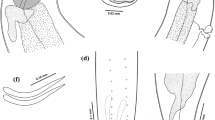Abstract
In the present study, we describe Oxysomatium brevispiculum n. sp. (Ascaridida: Cosmocercidae) parasitizing Amphisbaena alba Linnaeus (Squamata: Amphisbaenidae) in the municipality of Uberlândia, Cerrado Biome, Minas Gerais, Brazil. Oxysomatium brevispiculum n. sp. differs from its congeners by having shorter spicules and by the number and arrangement of caudal papillae. The males of the new species have a precloacal unpaired papilla and can be easily distinguished from O. caucasicum in which this morphological trait is absent. Oxysomatium brevispiculum n. sp. differs from the other three species of the genus by the number and arrangement of caudal papillae, with 13 pairs + 1 unpaired precloacal papilla, arrangement 8+1:2:3, while O. brevicaudatum has 14–16 pairs +1 unpaired papilla, and 7–9+1:1:6 arrangement, O. petrolinensis has 16 pairs +1 unpaired papilla, and 8+1:1:7 arrangement, and O. dollfusi with 15–16 pairs +1 unpaired papilla, and 8–9+1:1:6 arrangement. Oxysomatium brevispiculum n. sp. is the fifth species of this genus, the second species in a Neotropical host, and the first species of this genus described in amphisbaenid hosts. In addition, the present study provides an identification key for the species of this genus.


Similar content being viewed by others
Data availability
Not applicable.
References
Anderson, R. C. (2000) Nematode parasites of vertebrates: their development and transmission. 2nd ed. CABI, Wallingford, UK.
Anderson, R. C., Chabaud, A. G., & Willmott, S. (2009). Keys to the nematode parasites of vertebrates. Archival volume. CABI International, Wallingford, UK.
Baker, M. R. (1980). A revision of the genus Oxysomatium Railliet & Henry, 1916 (Nematoda, Cosmocercidae). Bulletin du Muséum National d’Histoire Naturelle, 2, 707–718.
Felix-Nascimento, G., Vieira, F. M., Muniz-Pereira, L. C., Moura, G. J. B, Ribeiro, L. B., & Oliveira, J. B. (2020). Two new species of Cosmocercidae (Nematoda: Cosmocercoidea) of Leptodactylus macrosternum Miranda-Ribeiro (Anura: Leptodactylidae) from Caatinga Biome, Brazil. Zootaxa, 4877, 274–290. https://doi.org/10.11646/zootaxa.4877.2.3
Gans, C. (1962). Notes on amphisbaenids (Amphisbaenia, Reptilia). 5: A redefinition and a bibliography of Amphisbaena alba Linné. American Museum Novitates, 2105, 1, 1–31.
Sharpilo, V. P. (1974). A new member of the genus Neoxysomatium Ballesteros Marquez, 1945 (Nematoda, Cosmocercidae) a parasite of slow worms of the Caucasus. Parazitologiya 8, 112–115.
Acknowledgements
We thank Dr. Bernadette Maria de Sousa for providing the dead host from which we collected the nematodes described here. This study was financed in part by the Coordenação de Aperfeiçoamento de Pessoal de Nível Superior - Brasil (CAPES) - Finance Code 001. Paula A. Gonçalves was supported by a Doctoral Fellowship from CAPES. Fabiano M. Vieira was supported by a Research Fellowship from Fundação de Amparo à Ciência e Tecnologia do Estado de Pernambuco (FACEPE), State of Pernambuco, Brazil (Process: BFP-0206-2.13/20).
Author information
Authors and Affiliations
Contributions
PAG, FMV and LCM-P contributed substantially to study conception and design. All authors contributed to data acquisition. FMV and SSL collected and prepared parasites for taxonomic studies. PAG, FMV, GF-N and LCM-P analyzed and interpreted the data. PAG, FMV, and GF-N wrote the manuscript first draft. All authors revised it critically. All authors read and approved the final manuscript.
Corresponding author
Ethics declarations
Conflict of interest
The authors declare no competing interests.
Additional information
Publisher's Note
Springer Nature remains neutral with regard to jurisdictional claims in published maps and institutional affiliations.
Rights and permissions
Springer Nature or its licensor (e.g. a society or other partner) holds exclusive rights to this article under a publishing agreement with the author(s) or other rightsholder(s); author self-archiving of the accepted manuscript version of this article is solely governed by the terms of such publishing agreement and applicable law.
About this article
Cite this article
Gonçalves, P.A., Vieira, F.M., Felix-Nascimento, G. et al. Oxysomatium brevispiculum n. sp. (Nematoda: Cosmocercidae) from Amphisbaena alba Linnaeus (Squamata, Amphisbaenidae) in the Cerrado Biome from Brazil. Syst Parasitol 101, 14 (2024). https://doi.org/10.1007/s11230-023-10129-w
Received:
Accepted:
Published:
DOI: https://doi.org/10.1007/s11230-023-10129-w




